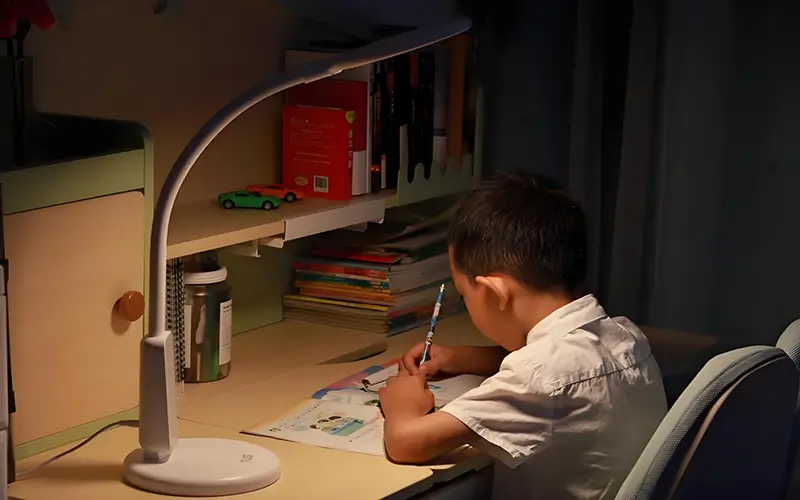
Light sources profoundly impact our daily lives, whether it is sunlight or artificial light sources. Especially when studying, reading, and playing. Different colors of light can directly affect our concentration, mood, and comfort. Therefore, choosing the right light ensures efficient learning, enjoyable reading, and easy playing. So let’s talk about what color lighting is best for studying, reading, and playing.
Definition and Classification of Light
Light refers to visible light emitted by a light source. It is used to illuminate a space, object or environment. It not only helps us see the surrounding environment clearly, but also affects our mood, concentration and work efficiency. According to the nature, color temperature and purpose of the light source, we can simply distinguish between lights.
Natural light and artificial light
- Natural light: light from the sun, which is the most natural light source. The color temperature and brightness of natural light will change over time.
- Artificial light: light produced by devices such as electric lights, LED lights or fluorescent lights. It can control brightness and color temperature by adjusting the device, suitable for different lighting needs.
Classification by color temperature
Color temperature refers to the color of the light, whether it looks “cold” or “warm”. Usually measured in Kelvin (K), the higher the color temperature, the colder the light.
- Cold light (5000K-6500K): The light appears brighter white or blue, suitable for environments that require concentration such as work and study.
- Neutral light (3500K-4500K): The color is more natural, close to the effect of daylight, suitable for home and office use.
- Warm light (2700K-3000K): The light presents a warm yellow or orange color, creating a comfortable and relaxing atmosphere. Suitable for use in bedrooms, living rooms and other places where relaxation is needed.
What are the Common Lights?
Before choosing the right light, it is very important to understand the common light colors. Each light has its unique functions and effects. According to the needs of different scenes, you can choose the corresponding light type. If you wanna to know the office lighting, pls read What Is The Ideal Color Temperature for Office Lighting?
White light
White light is one of the most common light sources. We can often find them in environments that require high brightness, such as offices, classrooms, and hospitals. White light has a higher color temperature (4000K-6500K), which is close to the brightness and coolness of natural light, so it can improve attention and efficiency.
Warm light
Warm light is low temperature with a yellow or orange hue. The color temperature is between 2700K-3000K and is often used in homes, cafes, restaurants, and other places where a warm and comfortable atmosphere is needed. Warm light makes people feel relaxed and is suitable for leisure and social occasions.
Red light
Red light is a soft light source with low brightness. It has special uses and is often used in night lighting or therapeutic lamps. Red light helps relieve stress and relax nerves, so it is more common in some treatment places or when used as a sleep aid.
Blue light
Blue light is commonly found in the luminous spectrum of electronic screens and displays. It is highly stimulating and can help improve concentration and alertness, so using blue light for a short period can improve work or study efficiency.
It is recommended not to look at blue light before going to bed, which helps the quality and stability of sleep.
What Kind of Color Lighting is Best for Studying and Reading?
Studying and reading requires efficient concentration and a good visual environment. So it is important to choose the right color lighting for studying. Light suitable for learning should be able to improve concentration and reduce eye fatigue.

White light
White colo lighting is usually the first choice for studying and reading because it is close to natural light. Its high color temperature (usually between 4000K-6000K) can improve concentration and alertness, especially suitable for learning environments that require long periods of concentration.
Warm light
Although warm light makes people feel warm and comfortable, it is suitable for resting or relaxing environments. It may make people feel sleepy. Warm color lighting is suitable for resting or relaxing environments and is not recommended for studying tasks that require high concentration.
Red light
Red light is less effective for learning. Mainly because its brightness is too low, it is not conducive to concentrating on learning to fly. So red light is not recommended for learning occasions. For more information about the red LED strip, pls read What Does the Red LED Strip Lights Do?
Blue light
Blue light is highly stimulating and can improve concentration, but long-term exposure to blue light may have a negative impact on the eyes. Therefore, blue light can be used as an aid in short-term high-intensity learning, but it is not recommended for long-term use.
What Kind of Color Lighting is Best for Playing?
Children need a light source that provides adequate lighting without making them feel tired. Different colors of light can change the gaming experience and also affect their mood.
White light
White light is suitable for most gaming scenarios, especially those that require clear vision and high reaction ability. For example, playgrounds, puzzles, etc. all require sufficient light to improve visual clarity and reaction speed.
Warm light
Warm light is suitable for a relaxed and social gaming environment. For example, at family gatherings and gatherings with good friends, warm light can bring comfort and help create a relaxing and pleasant atmosphere.
Red light
Red light can be used to create a special gaming atmosphere, such as a specific game. Although red light is not suitable for all games, it can help create a dramatic atmosphere in certain situations.
Blue light
Blue light may be effective in some games that require increased alertness and attention. Sometimes, blue light can help improve players’ concentration, but it is not suitable for long-term use because it may cause visual fatigue.
Conclusion
The choice of color lighting has a direct impact on studying. reading, and playing. Generally speaking, white light is usually the best choice for learning and most reading scenarios. Because it provides enough lighting while allowing people to maintain clear vision and high concentration.
Warm light, red light, and blue light are suitable for specific occasions, but are not suitable for long-term use, especially blue light, which has a strong stimulating effect on the eyes. Reasonable choice of light in different scenarios can not only improve efficiency, but also enhance the overall experience and comfort. If you need the LED strip, pls contact us.
FAQs
Generally speaking, we recommend cool white light. Cool white light (4000K-5000K) is best for studying because it is very similar to natural light. It is not too bright and not too glaring. It helps improve attention, concentration, and alertness.
Warm light (2700K-3000K) is usually not suitable for studying and is mainly used for gatherings and sleeping. Because it creates a cozy atmosphere that may cause sleepiness. It is more suitable for relaxation rather than high concentration.
Indeed, natural light is usually the first choice for studying. Because it can reduce eye fatigue and provide a balanced spectrum. If natural light is not available, cool white LED lighting is a good choice.
Yes, LED lights are very suitable for studying. Because they are energy-efficient, provide consistent lighting, and can be adjusted to different color temperatures, such as cool white or daylight, which is very useful for concentration.
